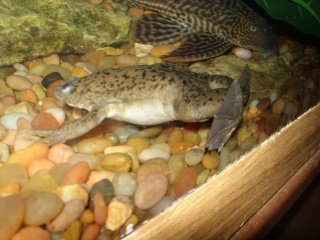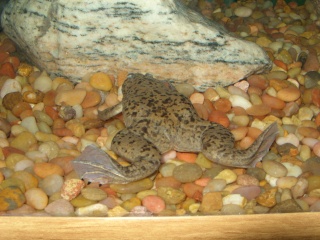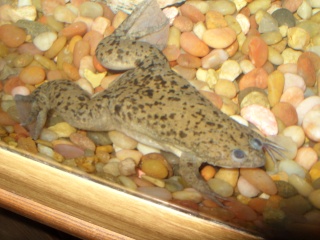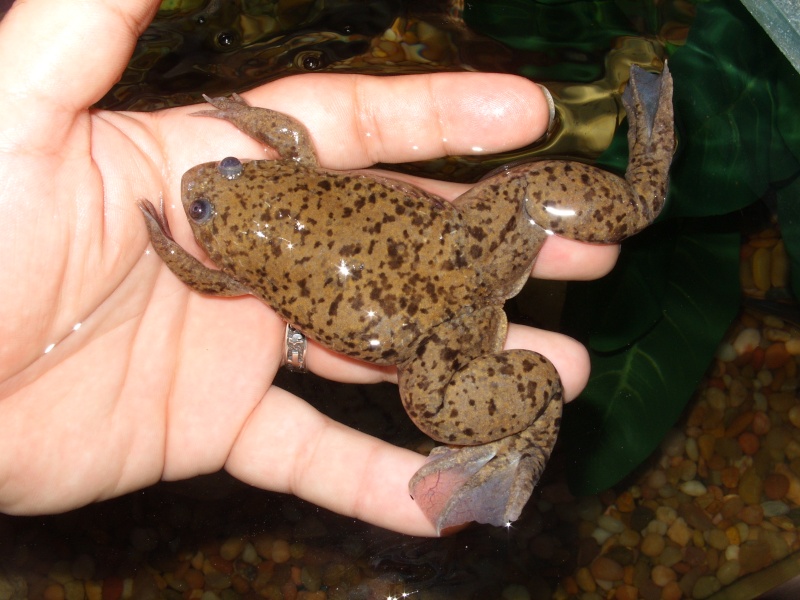| | | Species Profile: African Clawed Frog (Xenopus laevis) |  |
| | | Author | Message |
|---|
1nevrkwitz
Extraordinary Member

 Posts : 660 Posts : 660
Age : 55
Location : Missouri
Humor : I find humor, amusing.
Favorite Fish : Jack Dempsey
 |  Subject: Species Profile: African Clawed Frog (Xenopus laevis) Subject: Species Profile: African Clawed Frog (Xenopus laevis)  Mon Jun 08, 2009 10:55 pm Mon Jun 08, 2009 10:55 pm | |
| Species Profile: African Clawed Frog Scientific Name(s): Xenopus laevis Common Name(s): Scientific Name(s): Xenopus laevis Common Name(s): African Clawed Frog, clawed frog Origin: Warm lakes and ponds in Southern Africa Family: Pipidae Life Span: 15+ years in captivity Natural Habitat: In grassland ponds, streams, and lakes in the arid and semi-arid climates of Africa’s western Rift Valley. Habitat: African Clawed Frogs are fully aquatic. They are best housed in a glass aquarium with a secure screened lid. Each adult frog will require at least 10 gallons of water, and the water depth should be at least 12". Adolescent frogs on the other hand, may be, more comfortable with a water depth of 8". Skin Shedding: African clawed frog shed their skin every few weeks. They will eat the skin. Excessive skin shedding can indicate pollutants or irritants in the water. Interesting Facts/State Regulation: African Clawed Frogs have been used extensively in laboratory research. In the 1940s they were used to test for pregnancy in humans by injecting the frog eggs with the urine from women thought to be pregnant. As more sophisticated pregnancy testing became available, many of these frogs were released into the wild in the United States. Especially in southwestern areas of the country, they have become established and interfere with natural ecosystems. It is now illegal to import them or have them as pets in some states, so check with your local ordinances before purchasing one. Do to the release of captive African Clawed Frogs into the wild, the species is now found in many parts of the world in freshwater environments. Size/Appearance: The African Clawed Frog has smooth, slippery skin that ranges in color from grayish to brownish. It is mottled with darker shades of the same color. The belly is a creamy white. It has large webbed rear feet with three out of five toes ending in claws. Its front legs are small and lack webbing and claws. It has a flat head that looks small in comparison to its plump body, and its lidless eyes are on top of its head. Females generally reach up to 7 inches in length with their rear legs extended and are significantly larger and fatter than males that typically reach up to 5 inches.    Diet: Diet: The African clawed frog will accept a wide variety of foods. They are gluttonous eaters and, they will eat, almost anything that either smells appetizing, or moves like prey. For this reason, African clawed frogs should NEVER be kept with fish, African dwarf frogs, or other clawed frogs that will fit into their mouths. The African Clawed Frog does not have a tongue; instead, it uses its front toes as fingers to bring food to its mouth. Cooked, unseasoned shrimp, sinking and floating pellets, krill, flake, beef heart, and earthworms will be greedily accepted. Caution: The African clawed frog has been known to attack tank mates that are far to large for it to eat. Even though they are unable to swallow their larger tank mates, their rear claws could injure them. Temperament /Tank Mates: Peaceful towards anything that doesn’t fit in its mouth. These frogs will spend most of their time underwater, coming up to the surface only to breathe. They are very social, friendly frogs, and you can easily house more than one frog of the same sex in one tank as long as the tank is large enough to provide enough living space. Breeding: At night, males will emit a metallic clicking sound as their mating call, and females will answer back. If the female accepts the male, the sound she makes is described as "a rapping sound". If she rejects him, the noise she makes sounds like "a slow ticking." The fact that the female responds vocally is fairly unique. Once the female has accepted a male, the mating generally occurs at night. The male grasps the female, placing his forearms above her hind legs. This is called a "pelvic am plexus" (mating embrace). While in the male's grasp, the frogs move in a circular motion, and the sticky eggs (from several hundred to 2,000) are laid and fertilized while the frogs are upside down near the surface of the water. The frogs will continue to perform these somersault-like maneuvers until all the eggs have been laid. Interaction: Though you can handle your African Clawed Frog, it should be done with caution. They can very easily start to dry out if they are out of the water for more than a few minutes. Therefore, it is best to pet them while they are in the tank. They will probably nibble on your fingers when you do this, but they don't have teeth, so it is painless. My African Clawed Frog, Gorf, will happily swim into my hand every chance she gets to search for food.  | |
|   | | | | Species Profile: African Clawed Frog (Xenopus laevis) |  |
|
Similar topics |  |
|
| | Permissions in this forum: | You cannot reply to topics in this forum
| |
| |
| | Poll | | | Vote! | | Photo 1 | | 0% | [ 0 ] | | Photo 2 | | 40% | [ 2 ] | | Photo 3 | | 0% | [ 0 ] | | Photo 4 | | 0% | [ 0 ] | | Photo 5 | | 0% | [ 0 ] | | Photo 6 | | 20% | [ 1 ] | | Photo 7 | | 0% | [ 0 ] | | Photo 8 | | 40% | [ 2 ] |
| | Total Votes : 5 |
|
| Latest topics | » Can't believe this forum is still here Mon Sep 23, 2019 7:32 pm by Mostlycichlids» It's been a long time Tue Mar 04, 2014 9:11 pm by Celticwraith» Northeast Blizzard Mon Dec 16, 2013 9:14 pm by Grumpa» My Zoo Mon Oct 21, 2013 10:50 pm by Wyomingite» Nano Reef (pics) Wed Jun 12, 2013 9:04 am by dirtydawg10» Hello everyone! Wed Jun 12, 2013 9:02 am by dirtydawg10» trophus dubosi Sat May 11, 2013 9:55 pm by lincoln93k » Red Devil/Midas Tue Apr 30, 2013 1:53 pm by Wyomingite» Brand new stock with Ich Thu Mar 28, 2013 11:08 am by loshi » Some Photos Thu Mar 28, 2013 12:16 am by FISH CRAZY » my Pleco Thu Mar 28, 2013 12:12 am by FISH CRAZY » Happy Birthday Mostlycichlids! Wed Mar 27, 2013 11:47 pm by Mostlycichlids» Happy Birthday WYite! Wed Mar 27, 2013 11:46 pm by Mostlycichlids» My review on the Fluval 206 Wed Mar 27, 2013 11:45 pm by Mostlycichlids» Coupla Fish Pictures... Wed Mar 27, 2013 11:41 pm by Mostlycichlids» Hi all Thu Mar 07, 2013 8:20 pm by Wyomingite» High water hardness - is it safe? Mon Feb 25, 2013 6:55 pm by Wyomingite» Hello to all (New) Wed Feb 20, 2013 12:51 am by FISH CRAZY » Welcome sampsas! Thu Feb 14, 2013 12:46 am by Wyomingite» Welcome mrosser6364! Thu Feb 14, 2013 12:45 am by Wyomingite» Welcome AKfisher! Thu Feb 14, 2013 12:45 am by Wyomingite» Welcome beatriz.diazguijarro! Thu Feb 14, 2013 12:45 am by Wyomingite» Happy Birthday KeyMan57! Wed Feb 13, 2013 12:40 pm by dirtydawg10» Happy Birthday fishman232! Wed Feb 13, 2013 12:39 pm by dirtydawg10» Happy Birthday cichmann! Wed Feb 13, 2013 12:38 pm by dirtydawg10» 10 gallon fish tanks glass Mon Jan 28, 2013 2:59 pm by bogwood » Happy Birthday Brisch! Thu Jan 24, 2013 2:02 pm by Wyomingite» 90 Gallon in progress Wed Jan 23, 2013 9:58 pm by Grumpa» jwatsonx, Welcome to FWM! Wed Jan 16, 2013 11:12 pm by dirtydawg10» csa, Welcome to FWM! Fri Jan 11, 2013 4:34 pm by Mostlycichlids |
| Who is online? | In total there are 12 users online :: 0 Registered, 0 Hidden and 12 Guests
None
Most users ever online was 302 on Mon Jul 26, 2021 12:38 am
|
| Tools for Calculations and Conversions |
Calculations and Conversions
* Aquarium Volume Calculator
* Fahrenheit - Centigrade Conversion
* Carbonate Hardness Unit Conversion
* Liquid measurements
|
| Firefox | Freshwater Madness is best viewed with the Firefox web browser! Get It Now!
 Download Nowl
Download Nowl |
|







